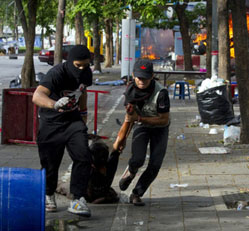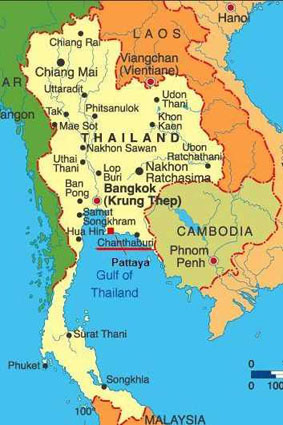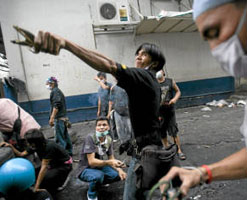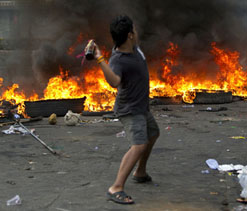What is going on in Thailand anyway?
May 20th, 2010 | By L. Frank Bunting | Category: In Brief
Anti-government supporters rescue a fellow Red Shirt who was shot after Thai army soldiers stormed barricades where thousands of protesters were encamped in Bangkok on May 19. ADREES LATIF/REUTERS Reuters.
“When the demonstrations began in Bangkok in March,” a New York Times report tells us, “the protesters’ central demand was that the government step down, but the movement has splintered and the ultimate aims have become unclear.”
You don’t have to spend too much time on the deeper background to the current troubles in Thailand to at least dimly grasp that there is no clear broader explanation of what is going on either. And if you are trying to figure out who occupies some pristine moral high ground – the “Yellow” government or the “Red” protest movement – forget it.
What is clear right now is spelled out in the headlines from various English language newspapers yesterday: “Thai army prepares crackdown on red-shirt protesters in Bangkok “ ; “Thai Army Moves on Protesters’ Encampment” ; “Thai army breaks through protesters’ barricades” ; “Thai armoured vehicles smash protester barricades” ; “Bangkok burns after Thai army violently storms protest zone” ; and “Tense curfew falls on Bangkok after violent crackdown.”
According to the New York Times (again): “Thai armored vehicles after dawn on Wednesday [May 19]Â rammed the barricades put up by antigovernment protesters …Â who have occupied Bangkok’s central retail district for more than six weeks … Senator Lertrat Rattanawanit, a former general who tried to mediate the crisis late on Tuesday [May 18], said negotiations had broken down because the protesters had ‘too many demands … The government and military will surely disperse the demonstration …Â and it will end today … But I cannot tell you what kind of damages and how many deaths there will be’.”
As later reported in the Toronto Star: “Bangkok is burning tonight after the Thai military overran the anti-government Red Shirts protest site, set protestors scattering and took custody of all of the movement’s main leaders following their surrender … As a government-ordered curfew was set to begin at 8 pm local time (9 am Eastern) as many as 20 fires were raging across the city, including the Bangkok Stock Exchange, the headquarters of Bangkok’s electrical grid, a high-end shopping complex and a cinema, as some protestors took their anger into other parts of the city.”
These immediate developments are bound to appear happily strange on the shores of the North American Great Lakes – even allowing for all the recent troubles of one sort or another here. But we do seem to be living in a global village in 2010, in certain key respects. The conflict that has turned some of the most affluent parts of Bangkok into an increasingly dangerous place has something to do with many of the broader issues that concern us all. And that is a large part of what makes it both so interesting and so disturbing too, no doubt.
1. It’s the economy stupid … especially in the rural northeast …
 As with everything else these days, everywhere else, problems in the underlying economic base certainly have a lot to do with the current troubles in Thailand. A May 18 Wall Street Journal article, eg, explained how: “In Beijing, as in Bangkok, the elites flaunt their newly acquired wealth … and stark social inequalities have stoked public anger … The frustrations that drive Thailand’s Red Shirt protesters, mainly poor farmers and urban workers backed by former Prime Minister Thaksin Shinawatra, also resonate in China.”
As with everything else these days, everywhere else, problems in the underlying economic base certainly have a lot to do with the current troubles in Thailand. A May 18 Wall Street Journal article, eg, explained how: “In Beijing, as in Bangkok, the elites flaunt their newly acquired wealth … and stark social inequalities have stoked public anger … The frustrations that drive Thailand’s Red Shirt protesters, mainly poor farmers and urban workers backed by former Prime Minister Thaksin Shinawatra, also resonate in China.”
Joshua Kurlantzick’s helpful “Red v. Yellow” article in the March 25Â London Review of Books also explains how “by 2007 household income in Bangkok was roughly three times that of households in the rural north-east … while the urban middle classes have benefited from trade and globalisation, the rural poor have seen the agricultural sector collapse in the face of competition from China and giant Western agribusinesses.”
The geography of economic discontent here has apparently now been reflected in the present protest movement initially centred in the capital city of Bangkok. According to a report in yesterday’s Globe and Mail: “Rioting also spread to the rural northeast of the country, where the bulk of the Red Shirt demonstrators are from. Local media reported that protesters had set fire to government offices in the city of Udon Thani and vandalized a city hall in Khon Kaen, also in the northeast. Udon Thani’s governor asked the military to intervene. TV images also showed troops retreating after being attacked by mobs in Ubon Ratchathani.”
Finally, as many travellers know nowadays, Thailand has for some time been the part of Southeast Asia most open to other parts of the world. Joshua Kurlantzick has explained how in “2008, the country had more than 14 million visitors – neighbouring Cambodia had two million – and tourism was the country’s biggest source of foreign exchange.” In the midst of the current crisis in 2010, however (as reported by the New York Times), “Thailand’s tourism industry, built on an image of gentleness, pleasure and smiles, is suffering its worst setback in decades – perhaps the worst in its history, according to tourism officials.”
2. Islam and legitimacy in southern Thailand …
![Soldiers Thai soldiers assemble in front of a barricade made by protesters in Bangkok on Wednesday [May 19]. Ahmad Yusni/European Pressphoto Agency.](http://www.counterweights.ca/blog/wp-content/uploads/2010/05/jthai04.jpg)
Thai soldiers assemble in front of a barricade made by protesters in Bangkok on Wednesday, May 19. Ahmad Yusni/European Pressphoto Agency.
To add to the complications here, the same former Prime Minister Thaksin Shinawatra, who had backed the current Red Shirt protesters from the rural northeast (before he was ousted from office by a military coup in September 2006) had himself been much more open to using military force against predominantly Muslim protesters from the southern provinces. Eventually, the “Thai army’s response to the crisis in the south attracted the interest of Arab satellite TV stations, Islamist websites, charities and foreign militant groups, to whom some southerners may have looked for guidance.”
It seems hard to judge just what role conflict between the Muslim-majority south and “Buddhist central Thailand” (and/or the north for that matter) may be playing in the current troubles. According to Kurlantzick, the “Rand Corporation estimates that between January 2004 and August 2007, militants in the south detonated no fewer than 1189 bombs and took part in 3253 drive-by shootings and assassinations.”

An anti-government Red Shirt protester launches a slingshot loaded with a large firecracker toward Thai soldiers as clashes continued in Bangkok on Monday, May 17. Getty Images.
This apparently helped set the stage for the military coup against the regime of former Prime Minister Thaksin Shinawatra in September 2006. How conflict between southern Muslims and central and northern Buddhists may figure in the current troubles in Thailand certainly remains unclear to me. (Kurlantzick simply reports that the “Thais are also divided by religion: the violence in the south has turned Muslims against Buddhists, generating tensions between the two groups in other parts of the country.”) But it does suggest some of the complexities of what is going on in the spring of 2010. And this may help explain why one “senior Thai diplomat” told Duncan McGargo: “I don’t know how we get out of this situation … It seems like a spiral.”
3. The (not so?) golden age of former Prime Minister Thaksin Shinawatra …
It may seem tempting to view the current struggle between the “Red” protesters and the “Yellow” government and its supporters in Thailand through the lens of the kind of pro-democracy protest movement that has recurrently bubbled up in neighbouring Burma (or Myanmar), around the leadership of the house-arrested Aung San Suu Kyi. And this impulse is stiffened by current press reports about “anti-government protests by the Red Shirts – formally called the United Front for Democracy Against Dictatorship.”
Yet Kurlantzick’s March 25 “Red v. Yellow” article throws considerable volumes of cold water in this direction. It is true enough, apparently, that the regime of former Prime Minister Thaksin Shinawatra, on which many Red Shirts now look back so fondly, had by “ his second year in office [2002] … more than tripled government expenditure on anti-poverty programmes, and over his time in office the percentage of the population living in poverty fell by nearly half.” One result was that: “In 2005, voters gave his party an even larger majority than in 2001; he and his allies now controlled 374 of the 500 seats in parliament.”
Kurlantzick goes on, however (presumably leaning for some of his evidence on Duncan McCargo’s book, but also on the testimony of one “Michael Montesano, one of the most astute observers of Thailand”) to report that Thaksin Shinawatra’s “policies also had a darker side. As Montesano notes, in many ways Thaksin resembled a Latin American caudillo more than a bland and consensus-building Thai leader. Not long after his election in 2001, he began dismantling the country’s democratic institutions … Thaksin’s administration forced long-serving civil servants to retire, replacing them with cronies, and some of his relatives were appointed to key positions in the armed forces … Facing charges of illegally concealing his assets, Thaksin was narrowly acquitted by the constitutional court … With his encouragement, a cult of personality was built up around him: billboards of his grinning face adorned highways and buildings across the country.”
Thaksin’s aggressively militaristic policies against Muslim protesters in the southern provinces are another case in point. On the other hand, as Kurlantzick explains: “Thaksin sparked an almost irrational level of anger among Thailand’s traditional elites – monarchists, Bangkok professionals, big businessmen –Â but not because of his actions in the south. Some of these people, who had fought for decades to modernise and democratise the country, abhorred his autocratic style. Others couldn’t stand his confrontational methods: he didn’t solve problems in the traditional Thai way, through backroom deals that allowed everyone to save face. Many feared too – correctly, as it turned out – that once the rural poor had seen the real power of their vote, they would never again tolerate the old oligarchic order.”
This finally led to the September 2006 military coup, which eventually put the present prime minister into office – “Abhisit Vejjajiva, a suave young British-educated technocrat … about as comfortable dealing with the working class as Prince Philip.” Kurlantzick goes on to explain here: “Following the coup, Thaksin went into exile, and now spends much of his time in Dubai, from where he regularly broadcasts messages back to Thailand.” (Although Thaksin went into exile in 2006, however, “the elites,” as Kurlantzick puts it, did not manage to “install” Abhisit Vejjajiva in office until late in 2008. Four other individuals served as interim prime ministers between Thaksin and Abhisit.)
It is also worth noting that before he became a politician Thaksin was a business tycoon who had amassed a considerable fortune. The comparison is no doubt not entirely apt, but in some respects he seems a kind of combination of Hugo Chavez and Silvio Berlusconi. As Kurlantzick further explains: “In February [2010] the courts seized the majority of Thaksin’s assets; his allies vowed to fight on … With Thaksin gone, his supporters have formed their own self-sustaining networks, which will probably survive even if he is no longer able to fund them. From exile, Thaksin promises: ‘I haven’t received justice and I will not give up.’”
4. The King and I …
If there are reasons to doubt Thaksin’s deepest democratic commitments, the democratic pretences of the present Abhisit Vejjajiva regime – against which the Red Shirts have been protesting – are no doubt even less impressive. Thaksin at least won two elections. (Or, as the BBC has put it: “A telecommunications billionaire, Mr Thaksin was the first prime minister in Thailand’s history to lead an elected government through a full term in office.”)
Current Prime Minister Abhisit Vejjajiva is the leader of something known as the Democrat or Democratic Party. Yet as explained on the BBC website: “The Democratic Party failed to win power at national elections [in 2008], but in December 2008 the Constitutional Court found the ruling party, led by allies of former Prime Minister Thaksin Shinawatra, guilty of electoral fraud and banned it … Amid the turmoil of the airport blockade caused by anti-Thaksin protesters, a few Thaksin loyalists changed sides … This enabled Mr Abhisit to form a new government and become the next prime minister without calling elections.” (Or as one Thai diplomat has rather disingenuously told Joshua Kurlantzick, in trying to explain the September 2006 coup: “‘The military was the best option … We had to stop democracy to save democracy.”)
A perceived need for fresh elections in many minds is certainly one ingredient in the current troubles. So the Toronto Star urged in a May 18 editorial: “For days, Thailand’s army has been sniping at civilian democracy activists who have barricaded themselves in the heart of Bangkok demanding new elections. Dozens have died in the past few days. It is an appalling spectacle … Prime Minister Abhisit Vejjajiva’s ultimatum to some 5,000 largely unarmed men, women and children to give up and disperse has left many fearing an imminent Tiananmen-style bloodbath … That would be a brutally futile denouement to a confrontation that should never have reached this sorry pass … Just weeks ago Abhisit offered to dissolve parliament and hold an election on Nov. 14. The “Red Shirt” protesters, meanwhile, pushed for a vote around Sept. 1. The 10-week gap should have been bridgeable. But both sides have retrenched, amid escalating violence.”
As the Toronto Star has also noted: “There’s no doubt that the military can suppress the protests.” And that does appear to be what is happening now. (Although on the latest reports the government has “extended an overnight curfew in Bangkok to 24 provinces — nearly one-third of the total,” and the current “unrest is the ‘most widespread and most uncontrollable’ political violence Thailand has ever seen, said political historian Charnvit Kasetsiri.”)
Yet back in his March 25 “Red v. Yellow” article, Kurlantzick voiced some sceptical reflections that still seem to make some sense today: “It is difficult to see a way back to stability. Right now, even a free election would be unlikely to calm things down … it would probably return Thaksin or his proxies to power, which would provoke his enemies all over again. The rural poor will never go back to the days when they simply accepted the rule of Bangkok. Yet the elites remain unwilling to give up any of their power … Thailand’s globalised economy may lead to even greater inequality between those who benefit from trade and investment and those, in the countryside, who do not.”
It is at this point that certain more exotic and unique sides to the Buddhist kingdom of Thailand seem to show both the limits and the underlying political and economic force of “globalization” in the early 21st century. Those of us who are old enough will remember the 1956 Hollywood movie “The King and I” with Yul Brynner and Deborah Kerr. It was a musical version of the 1946 film “Anna and the King of Siam” starring Irene Dunne and Rex Harrison, based on the book of the same name by Margaret Landon, based in turn on the experiences of the British governess Anna Leonowens and King Mongkut of what is now called Thailand in the 19th century.
As fate would have it, nowadays King Mongkut has a worthy descendant in King Bhumibol Adulyadej. And Joshua Kurlantzick ends his helpful March 25 article with some provocative speculations on this front: “Meanwhile, Bhumibol’s health is declining. At 83, he is the world’s longest reigning monarch, and the only remaining force holding Thai society together. There is good reason to fear that the political system will disintegrate after his death. Though in theory a constitutional monarch, the king actually wields great power … At critical moments, Bhumibol has mediated between opposing political forces; he helped to end previous protests against the military in 1973 and 1992 before too much blood had been spilled … many Thais worship him almost as a god … In recent months, worn down by frequent fevers [“a respiratory condition,” according to another source] , he has rarely ventured out in public; in the autumn, rumours of a turn for the worse in his health sent the stock market tumbling.”
Kurlantzick concludes: “Even in this condition, many Thais still hope that the king might bring the yellow and the red shirts together, for who else is there? Not his son and heir apparent, Crown Prince Maha Vajiralongkorn, a hothead who enjoys little respect even among the Thais who idolise his father. Many monarchists, who already despise Thaksin for challenging the power of the king, fear that the crown prince, who is known to be close to Thaksin, will create an opportunity for the exile to return. Few will speculate in public about the king’s future, but everyone tacitly admits that the country, which has muddled through so many crises, might collapse when he dies. According to one Thai legend, the Chakri dynasty, founded in 1782, will perish after its ninth monarch dies. Bhumibol, also known as Rama IX, is the ninth Chakri king.”

